Contact lenses are a great alternative to glasses if you need to correct your vision. Contact lenses let you see clearly, even in the rain, on hot days, and while doing sports like swimming, biking, and other intensive activities that aren’t glasses-friendly.
Thanks to modern contact lense technology, using contacts to correct your vision is easier, safer, and more effective than ever before.
If you want to choose the best contact lenses for daily use, read on—our researchers have ranked the best brands of contact lenses available.
Research
Rankings
1. Bausch + Lomb Biotrue ONEday

Bauch + Lomb introduced the very first disposable daily contact lens, and their daily contacts are still at the forefront of innovation today.
Biotrue ONEday is one of the best options on the market for people with dry eyes, thanks to their fantastic water content (78%) and their ability to maintain this high moisture content throughout the day as well as their good UV protection. These are a great all-around pick.
2. ACUVUE OASYS 1-Day
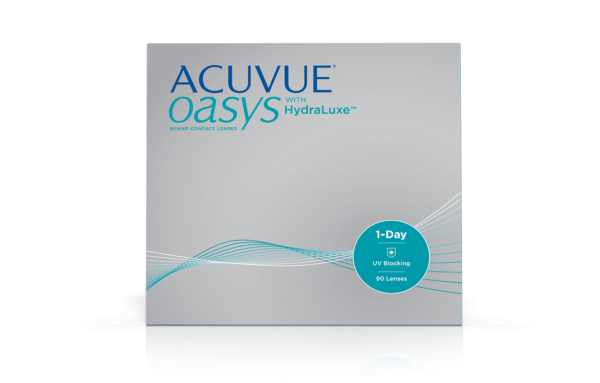
ACUVUE has long been a brand leader in contacts, and when it comes to all-purpose daily contacts, they’re still right near the front.
These daily disposable contacts have a moderate 38% water content, and have excellent ultraviolet light blocking capabilities: over 99% of UVB and over 96% of UVA light is blocked by these contacts, making them great for outdoor usage.
3. CooperVision Proclear 1 Day

CooperVision Proclear 1 Day has some of the best moisture retention and oxygen permeability on the market.
If you’ve had issues with dry, irritated eyes, especially at the end of the day, give these contacts a shot. The primary downside is that they do not provide great UV protection.
These contact lenses are fine for office work, but if you’ll be outdoors most of the day, opt for something with better UV shielding.
4. ACUVUE Moist Multifocal
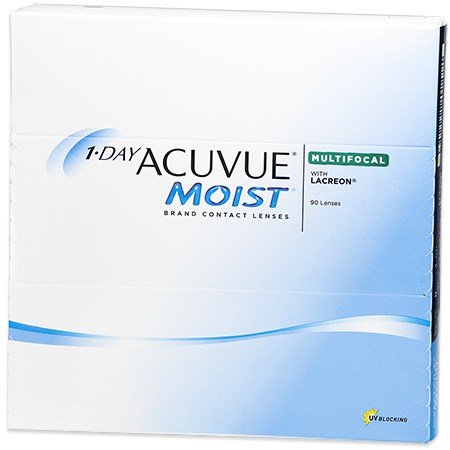
It can be hard to get multifocal contact lenses that feel comfortable and don’t dry out your eyes, but ACUVUE’s Moist line does a great job at both of these.
They’re just as thin as a normal contact lense, and they’ve got an impressive 58% water content. The UV protection is good for UVB (>97%), but only 82% for UVB rays.
Still, among the options on the market for multifocal contact lenses, ACUVUE is a great option.
5. AIR OPTIX Night & Day Aqua

If you’re traveling, camping, backpacking, or going anywhere else that requires extended contact wear, AIR OPTIX Night & Day is a great option.
These ultra-permeable contacts offer some of the best oxygen permeability on the market, and are FDA-approved for up to 30 days of continuous day and night wear.
Though long periods of continuous wear like this are associated with higher rates of side effects, the high oxygen permeability should help cut down on the prevalence of dry eyes, irritation, and other issues.
6. CooperVision Clariti and Clariti Multifocal
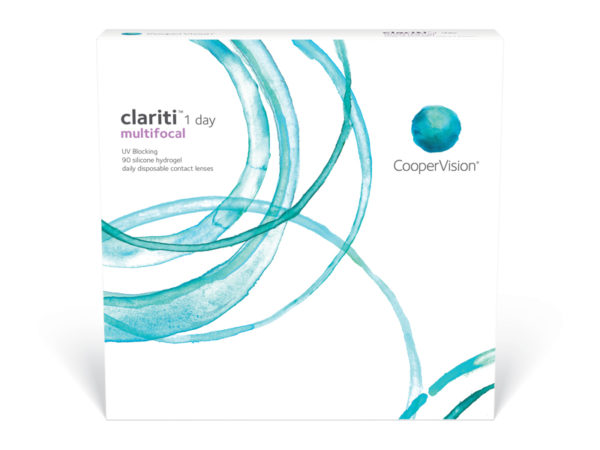
Getting multifocal contact lenses that are also daily disposables can be tricky, but CooperVision has got you covered. CooperVision Clariti makes it easy to get the vision advantages of multifocals, with all the benefits of daily disposable contacts.
On top of that, CooperVision Clariti offers a standard (unifocal) version of the contact, which is a great choice if you don’t need multifocal capabilities due to its good UV protection and solid water content, at 56%.
7. Alcon DAILIES AquaComfort Plus
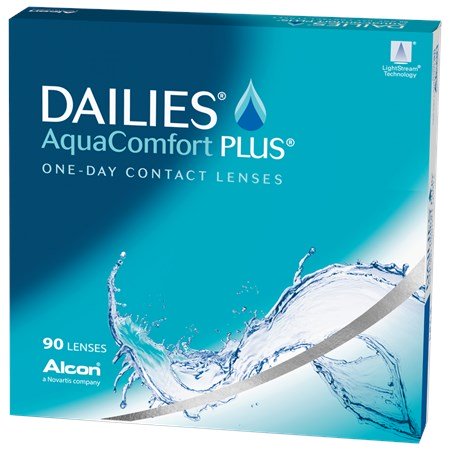
Alcon DAILIES AquaComfort Plus is a great option for people with irritable eyes. These contact lenses have a high water content (69%) and specially-designed moisturizing compounds.
The added benefit of not having to deal with cleaning and sanitizing contacts also reduces the risk of irritation from protein buildup on the lens itself.
The primary downside to these contact lenses is their lack of ultraviolet light protection as compared to some of the other offerings from Alcon and from other brands.
8. Bausch + Lomb Soflens Dailies
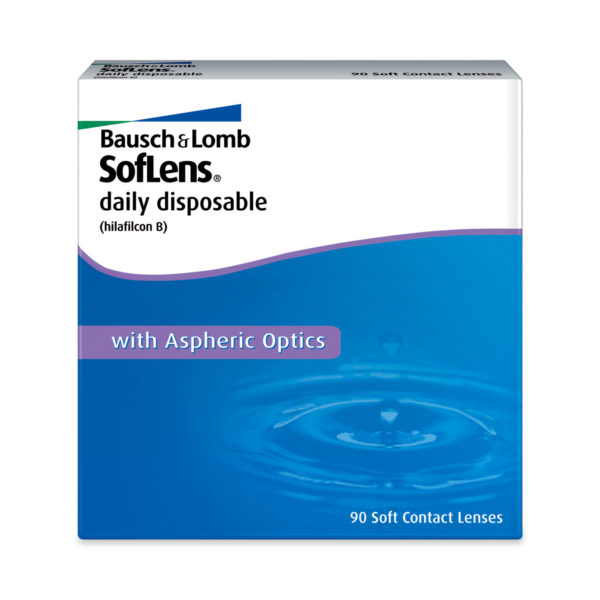
Soflens Dailies by Bausch + Lomb have a very respectable 66% water content and have been popular for a long time.
The primary downsides of these contacts are a lack of specific technology for combating dry eyes, and the lack of strong UV protection like you will find in other daily contact lenses.
9. Alcon Dailies Total1
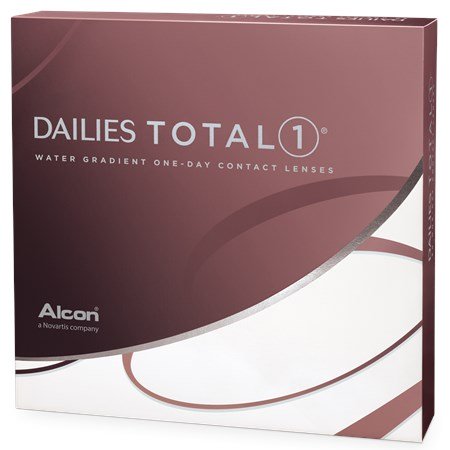
Alcon Dailies are a pretty standard option for daily disposable contacts. Their water content is a bit low, at 33% by weight, and their UV blocking is only middle-of-the-road: while they block 99% of UVB, they only block about 90% of UVA.
They’re worth a shot if you have had problems with irritation or a poor fit with other brands of daily contacts, but for most people there are better options on the market.
10. CooperVision Biofinity
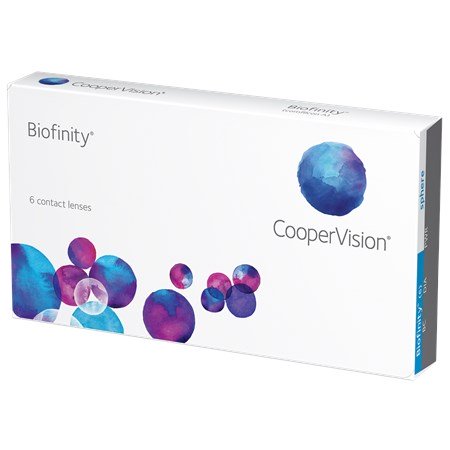
CooperVision Biofinity is one of the most popular brands of contacts on the market, thanks to their versatile uses and good extended wear properties.
They can be worn for up to seven days and six nights in a row, but after that they do need to be cleaned.
These contact lenses are designed to last for a month before replacement, so if you don’t want to carry a lot of individual contacts with you (for example, when traveling), they’re a good option to try.
For most people, though, we recommend going with daily contacts if at all possible because of the hygenic advantages.
Who should buy contact lenses?
If you need to correct your vision, contact lenses are the best way to do it. Glasses, though they’re simple and easy to use, don’t cut it in many situations: even the most expensive glasses fog up in humid or cold weather, can’t handle rain, and are easily broken or lost.
On top of that, glasses don’t cover your peripheral vision, which is an issue for playing sports and being active.
Glasses can also spell trouble in some situations if you need to wear other eye protection, like sunglasses or protective glasses (e.g. while doing construction).
Older contacts, sometimes called “conventional contacts” had several limitations. They couldn’t correct all types of vision problems, they required regular cleaning, and were expensive to replace.
On top of that, they carried the risk of dry eye and other complications.
Modern contact lens technology has addressed all of these issues. Many more vision problems can be corrected by contact lenses, disposable contacts have replaced the need for regular cleaning and have substantially reduced the risk of contamination and infection, and even offer advantages you can’t get from glasses, like better protection against UV light.
People who are sick of losing their glasses, having their glasses fog up, or not being able to see well in the rain are all great candidates for getting contact lenses.
If you use contact lenses now, but are still cleaning and sanitizing your contacts by hand, it might also be time to check out what the latest contact lens technology has to offer.
Modern contacts have major advantages over older conventional contacts, and are much more flexible (literally and figuratively) than glasses.
How we ranked
We based our contact lens rankings on the latest science on the efficacy of different types of contact lens technology, as well as the needs of different types of contact lens wearers.
We considered several different types of contact lens needs: daily disposable contacts, which are great for people with no particular special requirements; multifocal contact lenses, which are great for older adults who usually need reading glasses, extended wear contact lenses, which are useful for camping, traveling, and other situations where taking out contacts at night is a pain; and contact lenses for people with dry eyes.
We surveyed the available contact lens brands that fit into each of these categories. We only considered contact lenses made by major manufacturers that are widely available, as these tend to be the most reliable and the least likely to disappear (nothing’s worse than finding the perfect contact, only to have that brand disappear from the market a year later).
Using the latest scientific research, we narrowed down contact lenses in each category according to how well they hewed to the latest recommendations from eye health authorities and scientific research.
One of the major results of following these recommendations was our decision to strongly recommend disposable contacts, whether they be daily wear contacts or extended wear contacts.
The research is conclusive: because you do not have to take out, clean, and put back in these kinds of contacts, they result in far fewer side effects and are far less likely to harbor bacterial and fungal infections.
In addition to these evidence-based benefits, disposable contact lenses have additional benefits when it comes to convenience: you don’t need to buy a contact case or contact lens solution, you never need to clean them, and they’re far easier to travel with.
They can also be thinner and more permeable to oxygen, because they don’t need to last for weeks and months, which also contributes to their lower rates of side effects.
For contact lenses specifically for people with dry eyes, we looked for research-backed technologies like advanced hydrogel materials with a good water content level, as well as customer reviews from people with dry eyes.
Contact lenses for extended wear were evaluated particularly heavily on their oxygen permeability. One of the reasons why older conventional contact lenses were associated with side effects like eye redness and irritability is because they blocked the passage of oxygen from the air into the eyes.
Many of the medical references on the risks of long-term contact lens use are based on research done in the 1980s on long-term users of these conventional contacts.
Modern contacts, which are much more oxygen permeable (i.e. they allow more oxygen to pass through the lens) are thought to have a far lower rate of long-term complications.
Middling oxygen permeability is less of an issue for people who take their contacts out at night, but for extended wear, you really want high oxygen permeation in your lenses.
As a result, we looked particularly closely at oxygen permeability for the contact lenses in the extended wear category.
Another underlooked feature of contact lenses that we weighed in our rankings was ultraviolet (UV) light protection. UV rays are known to cause problems like cataracts and macular degeneration, and people who spend a lot of time outdoors can rack up a lot of ultraviolet light exposure.
Several of the top contact lens brands have special coatings that add substantial UV light protection, without degrading comfort or visual acuity. We gave extra points in our rankings to these contact lens brands.
When it came to aggregating the contact lenses in all the categories together into our final rankings, the most versatile products ended up at the top of the list.
Next up were contacts for people with dry eyes, alongside those designed for extended wear. The best multifocal contact lenses ended up a bit further down in the rankings, just because they are a bit more specialized. After pooling these results, we had our final list of the best contact lenses of the year.
Benefits
Contact lenses can replace your normal glasses and your reading glasses. New technology in “multifocal” contact lenses has enabled the production of contact lenses with multiple different focal points.
This means that older adults who usually need one set of glasses for seeing far away, and a different set of glasses for reading up close (i.e. reading glasses) can replace both of these pairs of glasses with just one contact lens.
Here’s how it works: by varying the optical curvature of the lens, certain areas of the lens (most often the center) are adapted for far-away vision, while other areas are adapted for close-up vision.
By using multifocal contact lenses, you can avoid having to use reading glasses for close-up work, even while having contacts that correct your distance vision.
Daily contact lenses are associated with fewer side effects than conventional contact lenses. Daily disposable contacts are probably the biggest innovation in vision correction technology in the last 30 years.
Previously, the convenience of contact lenses was offset by the need to clean and sanitize them carefully, lest you end up with bacteria or fungi growing in your contact lenses. As a consequence, long-term contact lens usage carried higher risks of eye irritation and other ocular problems.
However, thanks to the development of low-cost daily disposable contacts, these risks are far less of a problem. Scientific research has demonstrated clearly that daily contacts have a lower rate of side effects than conventional contacts.
One such study involved 12 different optometry practices across the United States and over 300 participants (1). One group was prescribed daily contact lenses, while the other group was prescribed conventional contact lenses that had to be cleaned and reused.
The results of the study showed that the subjects in the daily disposable contact group reported better vision, fewer side effects, and had objectively less deposits of material on their lenses at follow-up appointments.
Multiple other studies have come to the same conclusion: daily contacts are superior to conventional contacts, because they are far more hygenic and carry a lower risk of infection (2).
People with higher power prescriptions can benefit more from highly permeable contact lenses. One of the primary factors affecting eye comfort and eye health when you wear a contact lense is its oxygen permeability.
Like all tissue in your body, your eyes need oxygen to stay healthy. Remarkably, the tissue at the front of your eye gets part of its oxygen supply from the outside world, absorbing it directly through your eye.
Some of the health risks associated with contact lenses in early research in the ‘80s and ‘90s traced the emergence of eye problems in long-term contact lens users to low oxygen levels in the eye, because the contact lenses were blocking ocular oxygen supply from the air.
The solution to this has been to make contact lenses from materials that are highly permeable to oxygen (i.e. they let oxygen pass through the lens). Different contact brands and different materials have varying levels of oxygen permeability, and some research suggests that people who need strong prescriptions for their contacts should pay special attention to the oxygen permeability of their contacts.
A study published in the journal Contact Lens and Anterior Eye examined the oxygen permeability of several different contact lens brands as a function of their “power” (meaning the strength of the prescription) (3).
Not surprisingly, the strongest prescriptions—which had the thickest lenses—also had the lowest oxygen permeability.
However, brands differed substantially when it came to their permeability, which suggests that people who need strong prescriptions should pay special attention to the oxygen permeability of their contacts.
Permeability is measured in units of Dk/t, with values above 100 or so being fairly good, and with values below 50 being poor. For reference, some of the earliest contact lenses made in the 1970s had oxygen permeability in the single digits—we’ve come a long way since then.
Newer silicone hydrogel contacts are less susceptible to harboring bacteria. One of the perennial problems with contact lenses is that they provide a hospitable surface for bacteria to grow on.
This problem can be reduced by proper care for your contact lenses while cleaning them, as well as by using daily contact lenses, which are sterile up until you use them, and are discarded after a day.
Silicone hydrogel, the material used to make the top of the line contacts on the market today, is already known for being highly permeable to oxygen, but some evidence also suggests that it is less hospitable to bacteria when it’s actually in your eye.
A study published in the journal Optometry and Vision Science in 2008 studied how well bacteria adhered to conventional hydrogel and silicone hydrogel lenses, both before being worn and after being worn (4).
While there were no differences in bacterial adhesion before usage, after usage the silicone hydrogel lenses had significantly less adhesion of bacteria.
These findings provide further evidence for switching to modern contact lenses that use silicone hydrogels, as opposed to conventional hydrogels.
Side effects
Contact lenses are associated with a range of side effects, from mild eye irritation and redness to chronic dry eyes, corneal abrasion, and corneal ulcers.
Fortunately, these potential side effects can be mitigated by proper usage and selection of contacts (5). The easiest step you can take to reduce side effects from contact lenses is to switch to a daily disposable contact lens, and remove them at night.
Daily disposable contacts do not carry nearly the same level of risk of contamination that traditional contact lenses are associated with—all the trouble you have to go through to clean, rub, and sanitize contacts with two-step cleaners, overnight soaking, and so on is all to kill off bacteria and reduce the buildup of proteins on the surface of the lens.
Daily disposable contacts come in sealed, sterile solutions, and since you toss them after one day of use, you never have to worry about bacteria, contamination, or protein buildup. All you have to do is wash your hands well before you take them out or put them in.
While it’s certainly possible to take good care of conventional contacts by thorough, regular cleaning and replacement of contact lens cases, research shows that this isn’t the reality for most people.
For example, one study of university students in Hong Kong who used contact lenses found that up to one in three contact lense cases of regular contact lens wearers were contaminated with bacteria that are known to cause ocular problems (6).
Results from studies like these showed that—despite careful instructions and training—people just don’t bother to take good care of their contacts.
This pushed optometrists and industry to develop daily disposable contact lenses, which are a far superior choice when it comes to hygiene and side effects.
FAQ
Q: Are contact lenses safe?
A: Yes, thanks to modern innovations in contact lens technology, contact lenses are extremely safe when used properly.
Millions of people worldwide use contact lenses—with appropriate care, contacts can be used daily with very little risk of adverse effects.
The primary cause of eye problems resulting from contact usage is from inappropriate care—usually people not properly cleaning and storing their contacts.
The best way to avoid this is to use disposable daily contacts: they are always sterile before use, and you never have to bother with contact solution.
Q: Who cannot wear contact lenses?
A: There are some eye conditions that can’t be addressed by contact lenses, though fortunately, they tend to be rare.
If you have scarring on your cornea from a previous eye condition or eye injury, that may not be fully correctable by contact lenses, though they can still help. If you have “low vision,” which is not caused by focusing problems, you may also not get back to normal vision by using contact lenses.
There are also specific working conditions that prohibit using contact lenses. Though controversial, some (though not all) experts believe that contact lenses can pose special risks to people working with caustic chemicals, or while using machinery.
For example, Canada’s Center for Occupational Health and Safety notes that certain areas prohibit welding or grinding and abrading equipment (belt sanders, angle grinders, sand blasters, etc.) while wearing contact lenses (7).
The concern is that chemicals or small particles could permeate through the lens or float underneath it and be trapped between the contact and the eyeball, causing more damage than would otherwise have happened without contact lenses.
It’s worth noting that not all experts agree with this assessment, so you should check with your employer if you’re uncertain about whether contact lens usage is permitted.
Q: What are conventional contact lenses?
A: “Conventional contact lenses” usually refers to contacts that are designed to be cleaned and re-used for several weeks or months at a time.
These are an older type of contact lense, which were the only option when manufacturing contact lenses was difficult and expensive. Conventional contact lenses can be contrasted with modern disposable or “daily” contact lenses, which are worn once, then discarded.
Some variants of disposable contact lenses include extended and continuous wear contact lenses, which do not have to be taken off at night (for limited periods of time).
For most people, using disposable daily contact lenses is a better option than conventional contact lenses—they have a distinct advantage in terms of resistance to contamination and a lower rate of side effects, and are much more convenient to use, since you don’t need to bother with contact lens solution or with
Q: What are contact lenses made of?
A: Modern contact lenses are usually made of a type of material called a silicone hydrogel. Silicone is a type of compound called a polymers—a broad category that includes plastics, putties, and gels.
Hydrogels are a particular type of polymer that absorb huge amounts of water—a typical contact lens silicone hydrogel could be over half water, by weight.
These properties make modern contact lenses extremely flexible and permeable to oxygen, which helps to cut down on some of the side effects associated with contact lens usage in previous decades.
Q: Do contact lenses work for astigmatism?
A: Yes, contact lenses do work for astigmatism, though you need a special variant of lens. Contact lenses for astigmatism are sometimes called “toric” lenses, and come with special marks on them that help you put them in with the correct orientation.
Most of the top-rated brands from major contact lens manufacturers come with toric or astigmatism variants that offer all of the same features as the normal or “spherical” contacts of the same brand.
Q: How do contact lenses work?
A: The optics behind contact lenses are pretty simple: they work just like a magnifying glass or a photography camera lens, using transparent material to refract and bend light so it hits your eye in proper focus.
People who have normal vision have transparent biological material in their eye that performs this task naturally. However, if you are nearsighted or farsighted, the focal point of the light coming into your eyes is off by a bit.
By adding some transparent material with the right curvature, you can correct the abnormalities and focus light onto the correct spot in your eye. In this way, glasses are no different from contacts.
The added complexities of contact lenses have to do with getting this kind of focusing lens to sit in the right place, centered on your eye.
Q: What are multifocal contact lenses?
A: Multifocal contact lenses are designed for people who need vision correction both for far away objects, and for up-close objects.
Nearsightedness (the inability to see things that are far away) is very common, and as adults get older, they also tend to develop a condition called presbyopia (age-related farsightedness).
Usually, this combination requires one set of glasses for reading, and another set of glasses for everything else. With traditional contacts, you can cut it down to just needing reading glasses. Multifocal contacts are a way to deal with both problems at the same time.
By using different lens curvatures in different parts of the contact, a multifocal contact lens allows you to see both close up and far away.
Q: Can you store contact lenses without solution?
A: No, modern contacts can’t be stored without solution. They’ll dry out extremely quickly if you leave them out in the air, and other liquids, like tap water, aren’t sterile and will not clean away the protein and bacteria that build up on your contact lenses when they are in your eyes.
The trouble you have to go to in order to safely store reusable contacts is one of the reasons our team strongly recommends using disposable daily contacts for most people—you never have to carry around extra contact solution and carrying cases. And since they’re so cheap, it’s not a big deal to use a fresh pair if you have to take your contacts out for a few hours.
Q: Are contact lenses made of glass?
A: No, contact lenses are made of polymers—these are long chains of molecules that create a soft, flexible, and transparent material that is also highly absorbent to water, and permeable to oxygen.
Modern polymers like silicone hydrogels are very well-suited for the material properties needed by a modern contact lens. The high water content helps avoid dry eyes, and the soft, flexible properties of the polymer improve comfort.
Q: Are contact lenses bad for the environment?
A: One of the big objections to daily contacts is the potential environmental impact of the packaging. However, a few factors are at play.
First off, the plastic used to make the main case of a disposable contact is actually recyclable—you should save these and put them in your recycling bin instead of tossing them alongside the foil blister wrapper.
Second, compared to conventional contacts, daily contacts reduce much of the waste associated with producing and packaging contact cases and lens solution.
One study published in 2003 analyzed the environmental impact of different contact lenses, and found that daily contacts actually had less of an environmental impact than conventional contact lenses (8), and also concluded that contact lenses were a trivial fraction of the overall waste produced by a typical person.
The best way to reduce the environmental impact of your contact lens usage is to make sure you recycle all of the recyclable plastic, and buy contacts in bulk to reduce packaging waste and emissions associated with shipping. Also, avoid tossing your used contacts down the drain—put them in the trash instead.
Related articles
Recap
Contact lenses are great for seamlessly and effortlessly correcting your vision. For most people, the best option is a daily disposable contact lens: these lenses are the safest and easiest to use, and because you discard them at the end of the day, they harbor far less bacteria and protein buildup.
If you spend a lot of time outdoors, looking for contact lenses that offer ultraviolet light protection is well worth the time, because of the link between UV exposure and eye problems like cataracts and macular degeneration.
Older adults often benefit from multifocal contact lenses, and if you need to leave your contacts in for several days at a time, getting silicone hydrogel contacts with high oxygen permeability is the best move for getting a contact lens that will not irritate your eyes.
For BodyNutrition‘s #1 contact lenses recommendation, click here.